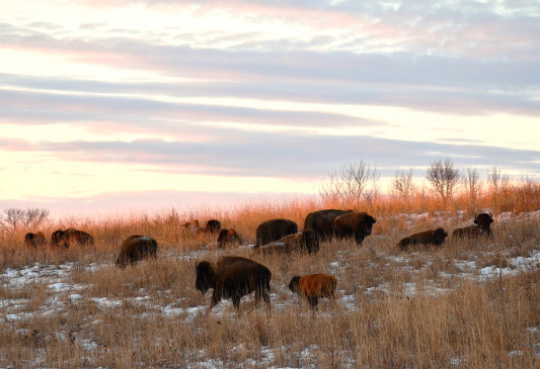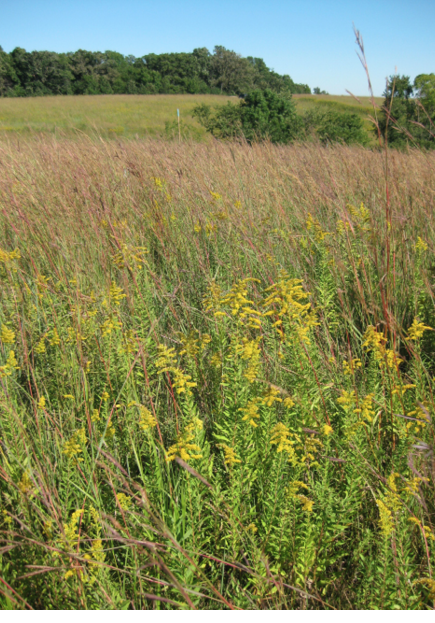Let a man decide upon his favorite animal and make a study of it…let him learn to understand its sounds and motions. The animals want to communicate with man, but Wakan-Tanka does not intend they shall do so directly —man must do the greater part in securing an understanding.
—Brave Buffalo of Standing Rock Reservation (Lakota) 1
Recently, I learned about the Oglala Lakota tribe’s history and relationship with bison, the largest land mammal in North America. In the mid-sixteenth century, the North American prairie was home to an estimated 40 million bison and tens of thousands of Lakota people. By the mid-nineteenth century, the bison had all but been eradicated and the Lakota population, greatly reduced, forced into reservations. For the Oglala and Lakota, bison are incredibly meaningful culturally and spiritually. 2 To them, the bison are one with the Earth and represent all growing and living beings. 3 In myth, the “White Buffalo Cow Woman” 4 presented the Oglala with a sacred pipe and seven sacred rites, providing the Oglala with wisdom, survival, and power. 5 While the buffalo, otherwise known as Wakan-Tanka, represent all beings, they are also equated specifically with women. I was inspired by the bison’s central role in Oglala Lakota understandings of the natural world and social relationships, and as a poet I wanted to express my thoughts and feelings about the bison in verse. In the poetry that follows, I combine my recent encounters with bison in central Iowa at the Neal Smith National Wildlife Refuge with what I’ve learned about the Oglala Lakota. I have learned about the Oglala Lakota’s relationship with bison from a mix of primary and secondary sources which I’ve included below. I have only begun to learn about the bison and the Oglala Lakota, and recognize how much I do not know. My learning and application of it is shaped by my experiences, which are not indigenous.

Photo courtesy of Jon Andelson
watching the bison
do not come too close to me, he says, with strong brown eyes that contain the world.
She stands atop
packed black dirt,
Facing me
as I forget my self, forget my name, feel my breath, feel hers too
Shadows cast by the afternoon sun. reflecting their sacred bodies,
moral behavior power survival entangled within their woolly dense fur
the tatanka,“buffalo,” are four-legged people, 6
who hold a mystery of sacred life,
which travels
in dust
formed playfully wallowing, rubbing their backs
with packs
of Earth’s colorful skin.
the prairie is a privilege
A friend’s water bottle sticker reads, the prairie is a privilege, and I ask what that means to him.
The prairie is a privilege, he says, with its mixed grasses, one of the most endangered
ecosystems in the world.
The prairie is a privilege, home to sixty million bison for ten thousand years, until mass killing
committed first by white hunters, who sold hides and meat,
then by travelers, shooting from trains for greed.
In eighteen eighty-three the
United States Army forced starving Native people deprived of their food and way of life
to live on reservations, bringing Native Americans under U.S. government (white men’s) control
“minimizing
conflict"
between Native Americans and foreign settlers
“encouraging”
Native Americans to
“take on the
ways of
white men" 7
The prairie is a privilege,
holding within its rich roots the bleached white bones of sacred beings,
once one of the most abundant large animals of all time.
herds were stampeded by American military men
for land and for freedom. maimed masses at the bottom of cliffs for the
repression
and
death
of fellow human beings.
“That animal was like a part of ourselves, a part of our souls.”
-Lakota medicine man Lame Deer 8
becoming a woman
red smoke
escapes into the sky from the buffalo cow
as a calf is born,
chokecherries and water are placed in a wooden bowl,
a new woman and medicine man drink the red liquid like buffalo.
She is painted red, sacred like her first menstrual flow.
She is now a buffalo Woman, one with the White Buffalo Cow Woman, who brought sacred ceremonies so
the Oglalas may live.
Bison are one with the universe, naturally containing the
totality
of all manifest
forms of
life. 9

Photo courtesy of Joan Van Gorp
excerpts and notes from Where Have All the Bison Gone? 10
without regular fire,
woody plants
invade
the meadows, displacing
the grass.
more firearms than fire sent
eastern bison on a
long
slow
slide to
oblivion.
the bison do not run once hunters begin killing the herd. They do not flee the unknown cloud of black smoke
from Sharps rifles, boom!
Why does the herd stand for slaughter?
was it because the boom sounded like a thunderclap?
or maybe, the bison were not scared of man.
Bison are powerful animals, with
hooves sinking deep
into Earth.
they turn directly to face
harsh winter winds,
shake their heads in snow to find buried grass.
the Bison do not fear the human, but teach them to live well.

Photo by Jun Taek Lee
Maka Ina, ‘Mother Earth’
Unšike, ’the pitiable,' 11
some traditional Ogalala women believe in the pipe and the sacred rites.
they pray to Wakantanka. Smoke the pipe and wait.
they are concerned with unšike, the common people of the world.
the white man is nothing more than a visitor to their world, one day destined to pass into oblivion.
The buffalo and old Indigenous people will be born again.
They look longingly
out at the prairie,
and wake
from sleep with visions and
premonitions,
sometimes visited by loved ones long passed.
these Women are believed to be powerful because they are close to the spirit world.

Photo courtesy of Joan Van Gorp
1 Brown, Joseph Epes. Animals of the Soul: Sacred Animals of the Oglala Sioux. Element, 1998.
2 Ibid.
3 Ibid. Note that here I use the words bison and buffalo interchangeably, referring in each instance to the same animal, although technically the species Bison bison is not related to buffalo at all. I use them interchangeably because many of the sources I reference do also
4 Ibid.
5 Lewis, Thomas H. The Medicine Men: Oglala Sioux Ceremony and Healing (Studies in the Anthropology of North American Indians) University of Nebraska Press, 1992
6 Brown, Joseph Epes. Animals of the Soul: Sacred Animals of the Oglala Sioux. Element, 1998.
7 Onion, Amanda, et al.
8 Brown, Joseph Epes. Animals of the Soul: Sacred Animals of the Oglala Sioux. Element, 1998.
9 Powers, Marla N. Oglala Women Myth, Ritual, and Reality. University of Chicago Press, 1986.
10 Lott, Dale F. American Bison: A Natural History. 1st ed. University of California Press, 2002. http://www.jstor.org/stable/10.1525/j.ctt1ppxd1.
11 Powers, Marla N. Oglala Women Myth, Ritual, and Reality. University of Chicago Press, 1986.


